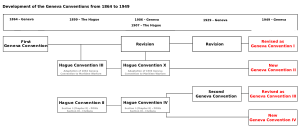Difference between revisions of "Geneva Conventions (1949)" - New World Encyclopedia
(submitted) |
Laura Brooks (talk | contribs) (images ok) |
||
| Line 1: | Line 1: | ||
| − | {{Claimed}}{{Contracted}}{{Submitted}} | + | {{Images OK}}{{Claimed}}{{Contracted}}{{Submitted}} |
[[Image:Original Geneva Conventions.jpg|thumb|Original document.]] | [[Image:Original Geneva Conventions.jpg|thumb|Original document.]] | ||
[[Image:Geneva Conventions 1864-1949.svg|thumb|Development of the Geneva Conventions from 1864 to 1949.]] | [[Image:Geneva Conventions 1864-1949.svg|thumb|Development of the Geneva Conventions from 1864 to 1949.]] | ||
Revision as of 18:43, 23 December 2007
The Geneva Conventions consist of four treaties formulated in Geneva, Switzerland, that set the standards for international law for humanitarian concerns. They chiefly concern the treatment of non-combatants and prisoners of war. They do not affect the use of weapons in war, which are covered by the Hague Conventions of 1899 and 1907 and the Geneva Protocol on the use of gas and biological weapons of 1925. They were founded by two young men - Henry Dunant, founder of the Red Cross movement and Gustave Moynier, a co-founder - who cordially loathed each other. The role of the Red Cross and Red Crescent, a voluntary humanitarian organization as a non-state actor in monitoring the treatement of prisoners of war, and the conduct of war according to international law, is an example of how civil society, because it is sometimes more neutral than states, can play a pivotal part in helping to create a better, more humane world.
Background
The Conventions were the results of efforts by Henry Dunant, who was motivated by the horrors of war he witnessed at the Battle of Solferino in 1859. The adoption of the First Convention followed the foundation of the International Committee of the Red Cross whose founder, Henry Dunant, initiated international negotiations that produced the Convention for the Amelioration of the Wounded in Time of War in 1864. [1]
Because some belligerents in World War II had abused the principles contained in earlier conventions, an International Red Cross conference in Stockholm in 1948 extended and codified the existing provisions. The conference developed four conventions, which were approved in Geneva on August 12, 1949
In the decades following World War II, the large number of anticolonial and insurrectionary wars threatened to render the Geneva Conventions obsolete. After four years of Red Cross-sponsored negotiations, two additional protocols to the 1949 conventions, covering both combatants and civilians, were approved in 1977.
As of 2 August 2006,[2] when the Republic of Montenegro adopted the four conventions, they have been ratified by 194 countries.
As per article 49, 50, 129 and 146 of the Geneva Conventions I, II, III and IV, respectively, all signatory states are required to enact sufficient national laws that make grave violations of the Geneva Conventions a punishable criminal offense, this is what created the international criminal court. More than 180 states have become parties to the 1949 conventions. Approximately 150 states are party to Protocol I; more than 145 states are party to Protocol II, though the United States is not. In addition, more than 50 states have made declarations accepting the competence of international fact-finding commissions to investigate allegations of grave breaches or other serious violations of the conventions or of Protocol I.
The conventions and their agreements
- First Geneva Convention "for the Amelioration of the Condition of the Wounded and Sick in Armed Forces in the Field" (first adopted in 1864, last revision in 1949)
- Second Geneva Convention "for the Amelioration of the Condition of Wounded, Sick and Shipwrecked Members of Armed Forces at Sea" (first adopted in 1949, successor of the 1907 Hague Convention X)
- Third Geneva Convention "relative to the Treatment of Prisoners of War" (first adopted in 1929, last revision in 1949)
- Fourth Geneva Convention "relative to the Protection of Civilian Persons in Time of War" (first adopted in 1949, based on parts of the 1907 Hague Convention IV)
In addition, there are three additional amendment protocols to the Geneva Convention:
- Protocol I (1977): Protocol Additional to the Geneva Conventions of 12 August 1949, and relating to the Protection of Victims of International Armed Conflicts. As of 12 January 2007 it had been ratified by 167 countries.
- Protocol II (1977): Protocol Additional to the Geneva Conventions of 12 August 1949, and relating to the Protection of Victims of Non-International Armed Conflicts. As of 12 January 2007 it had been ratified by 163 countries.
- Protocol III (2005): Protocol Additional to the Geneva Conventions of 12 August 1949, and relating to the Adoption of an Additional Distinctive Emblem. As of June 2007 it had been ratified by 17 countries and signed but not yet ratified by an additional 68 countries.
All four conventions were last revised and ratified in 1949, based on previous revisions and partly on some of the 1907 Hague Conventions; the whole set is referred to as the "Geneva Conventions of 1949" or simply the "Geneva Conventions." Later conferences have added provisions prohibiting certain methods of warfare and addressing issues of civil wars. Nearly all 200 countries of the world are "signatory" nations, in that they have ratified these conventions. [3]
Clara Barton was instrumental in campaigning for the ratification of the First Geneva Convention by the United States; the U.S. signed in 1882. By the Fourth Geneva Convention some 47 nations had ratified the agreements.
Other Geneva Conventions
Other conventions of the United Nations taking place in Geneva and agreements signed there have become part of international and national laws, but are not to be confused with the above-mentioned treaties though they may be referred to as "Geneva Conventions." These include the Convention on the Territorial Sea and the Contiguous Zone, the Convention Relating to the Status of Refugees (1951) and Protocol relating to the Status of Refugees (1967), and others.
See also
- Human rights
- Red Cross
- Laws of war
- War crime
Notes
- ↑ The text is given at the ICRC website, Resolutions of the Geneva International Conference Retrieved December 14, 2007.
- ↑ Geneva Conventions of 12 August, 1949 State Parties, Signatories Geneva Conventions of 12 August 1949, Parties / Signatories Retrieved December 14, 2007.
- ↑ Texts of all related docuemnts available at the ICRC., 1949 Conventions and 1977 Protocols Retrieved December 14, 2007.
ReferencesISBN links support NWE through referral fees
- Bennett, Angela. 2005. The Geneva Convention the hidden origins of the Red Cross. Stroud, Gloucestershire: Sutton. ISBN 9780750941471
- Diplomatic Conference on the Reaffirmation and Development of International Humanitarian Law Applicable in Armed Conflicts, and Howard S. Levie. Protection of War Victims Protocol 1 to the 1949 Geneva Conventions. Dobbs Ferry, NY: Oceana Publications, 1979 ISBN 9780379007862
- Jinks, Derek. 2005. The rules of war: the Geneva Conventions in the age of terror. New York: Oxford University Press. ISBN 9780195183627
- Levie, Howard S. The Law of Non-International Armed Conflict Protocol II to the 1949 Geneva Conventions. Scientific collection of the Henry Dunant Institute. Dordrecht: M. Nijhoff, 1987 ISBN 9789024734917
- Roth, Kenneth, Minky Worden, and Amy D. Bernstein. 2005. Torture - does it make us safer? is it ever OK?: a human rights perspective. New York: New Press. ISBN 9781595580573
External links
- Texts and commentaries of 1949 Conventions & Additional ProtocolsRetrieved December 4, 2007.
- ICRC overview of the Geneva ConventionsRetrieved December 4, 2007.
- Reference Guide to the Geneva ConventionsRetrieved December 4, 2007.
- www.SupportGenevaConventions.info: Coalition for re-affirming and extending the Geneva Conventions.Retrieved December 4, 2007.
Credits
New World Encyclopedia writers and editors rewrote and completed the Wikipedia article in accordance with New World Encyclopedia standards. This article abides by terms of the Creative Commons CC-by-sa 3.0 License (CC-by-sa), which may be used and disseminated with proper attribution. Credit is due under the terms of this license that can reference both the New World Encyclopedia contributors and the selfless volunteer contributors of the Wikimedia Foundation. To cite this article click here for a list of acceptable citing formats.The history of earlier contributions by wikipedians is accessible to researchers here:
The history of this article since it was imported to New World Encyclopedia:
Note: Some restrictions may apply to use of individual images which are separately licensed.

